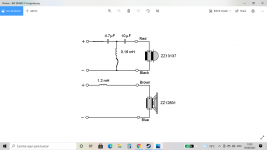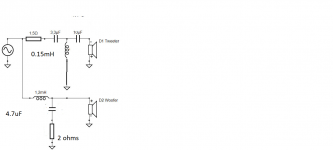in some cases, there is some smoothing applied, so the suckout is less noticeable, but its there
in all cases, phase is significantly different, easy to spot
if messed up phase does not bother you bentoronto, its ok with me, but I like to do things right, even its just a hobby
in all cases, phase is significantly different, easy to spot
if messed up phase does not bother you bentoronto, its ok with me, but I like to do things right, even its just a hobby
Thanks for the data.
I know it is very obvious to you what we are supposed to see, but could you just walk us through what we are supposed to be noticing.
If there is suck-out on some of your plots, does it correspond to the "right" or "wrong" polarity?
Thanks.
B.
I know it is very obvious to you what we are supposed to see, but could you just walk us through what we are supposed to be noticing.
If there is suck-out on some of your plots, does it correspond to the "right" or "wrong" polarity?
Thanks.
B.
ALPUY, I ran a sim of your B&W DM602 S1 loudspeaker.
Software | Visaton
It confirmed what I expected. Even adding a 1.8R/4.7uFshunt didn't change phase much or polarity at all. It is the usual positive polarity with this sort of 2nd/3rd order filter. Don't know if Rutcho made a mistake on his wiring...
B&W Bowers Wilkins DM 601-S3 Crossover Upgrade for Better Midrange Perfoprmance
A single coil on a Kevlar bass is just asking for breakup around 5kHz. The 1.8R in the tweeter shunt is spoiling the rolloff.
I'd try positive polarity first. I can't think of a simple two-way that doesn't use it.
One curiosity I noticed was the bass impedance was very low at 200Hz, more a 4 ohm driver's territory than a 6 ohm DC driver. Worth measuring with a multimeter. Suggests to me that 1.2mH might work well with a simple 6.8uF shunt if I know my 6" two ways.
Software | Visaton
It confirmed what I expected. Even adding a 1.8R/4.7uFshunt didn't change phase much or polarity at all. It is the usual positive polarity with this sort of 2nd/3rd order filter. Don't know if Rutcho made a mistake on his wiring...
B&W Bowers Wilkins DM 601-S3 Crossover Upgrade for Better Midrange Perfoprmance
A single coil on a Kevlar bass is just asking for breakup around 5kHz. The 1.8R in the tweeter shunt is spoiling the rolloff.
I'd try positive polarity first. I can't think of a simple two-way that doesn't use it.
One curiosity I noticed was the bass impedance was very low at 200Hz, more a 4 ohm driver's territory than a 6 ohm DC driver. Worth measuring with a multimeter. Suggests to me that 1.2mH might work well with a simple 6.8uF shunt if I know my 6" two ways.
System7. I appreciate the willingness to do a simulation of the BW DM602 S1.
If I have not misunderstood, should I leave the 1.8 ohms + 4.7uF resistor in the low pass? or should I remove it ?.
The 1.5 ohm resistor is either high pass or bad.
Original crossover
Upgrade
If I have not misunderstood, should I leave the 1.8 ohms + 4.7uF resistor in the low pass? or should I remove it ?.
The 1.5 ohm resistor is either high pass or bad.
Original crossover
Upgrade
Attachments
Forget the resistor and buy an L-pad.
In the absence of parametric EQ (such as DSP) or bi-amping, you need some means of adjusting loudness. Otherwise, you are putting unwarranted faith in the Engineering Fairy.*
B.
*If the Engineering Fairy knew ALL about your room, your hearing, your taste in recordings, etc., then maybe a different story
In the absence of parametric EQ (such as DSP) or bi-amping, you need some means of adjusting loudness. Otherwise, you are putting unwarranted faith in the Engineering Fairy.*
B.
*If the Engineering Fairy knew ALL about your room, your hearing, your taste in recordings, etc., then maybe a different story
I seem to recall I bought my nephew and his spouse a pair of DM601 S2 for their wedding present. 🙂
While considered the £200 top speaker of the year by the magazines, I found them a bit of a headache to listen to on a visit to their flat. Overly bright at the top and a bit harsh on breakup. Oh well. 😱
You are in a bit of luck with the adjustments to the top end. Being biwireable, the top end can be adjusted externally. I can't make much case for changing the first tweeter capacitor to 3.3uF from 4.7uF. To take tweeter down, you just wire, say, 2.2R or 3.3R (3-5W) from bass positive to tweeter positive on single input to bass. The copper strap on negative stays in place.
Very easy. Actually, you could wire that resistor in series with a 10uF, which you should have left over, and if my calculations don't fail me, that would adjust the 4.7uF to about 3.3uF anyway. 3.19uF to be precise.
I notice other people also recommend positive polarity too:
https://www.diyaudio.com/forums/multi-way/328314-dm602-s3-crossover-mod-2.html#post6716383
Any different changes to the bass filter than 4.7 plus 1.8R should be in light of a resistance measurement across the bass input. Or better still the bass itself without the coil, which would likely be near an ohm, being aircore.
I often add a zobel across metal tweeters. Around 6R and 1uF at a complete subjective guess.
While considered the £200 top speaker of the year by the magazines, I found them a bit of a headache to listen to on a visit to their flat. Overly bright at the top and a bit harsh on breakup. Oh well. 😱
You are in a bit of luck with the adjustments to the top end. Being biwireable, the top end can be adjusted externally. I can't make much case for changing the first tweeter capacitor to 3.3uF from 4.7uF. To take tweeter down, you just wire, say, 2.2R or 3.3R (3-5W) from bass positive to tweeter positive on single input to bass. The copper strap on negative stays in place.
Very easy. Actually, you could wire that resistor in series with a 10uF, which you should have left over, and if my calculations don't fail me, that would adjust the 4.7uF to about 3.3uF anyway. 3.19uF to be precise.
I notice other people also recommend positive polarity too:
https://www.diyaudio.com/forums/multi-way/328314-dm602-s3-crossover-mod-2.html#post6716383
Any different changes to the bass filter than 4.7 plus 1.8R should be in light of a resistance measurement across the bass input. Or better still the bass itself without the coil, which would likely be near an ohm, being aircore.
I often add a zobel across metal tweeters. Around 6R and 1uF at a complete subjective guess.
You're telling me that the high-pass tests do it outside at the connection terminals.
and that removes the 4.7uF and 1.8 ohms resistor from the low pass?
I clarify that my BW are dm 602 not 601.
and that removes the 4.7uF and 1.8 ohms resistor from the low pass?
I clarify that my BW are dm 602 not 601.
Excuse me for insisting on something that may be obvious to others.
But I'm not fluent in English. Maybe a scheme would be useful to me.
But I'm not fluent in English. Maybe a scheme would be useful to me.
What I am saying is that with a 4 terminal biwireable connection, often shunted by two copper strips, the bass and tweeter circuits can be completely seperate!
So you can adjust tweeter level from the outside with resistors. Easy.
The tweeter level resistor connects positive bass input to positive tweeter input. To complete the circuit you must short the negative terminals. The 4.7uF and 1.8R or 2R or 2.2R stays in place, since it is a GOOD THING that reduces bass breakup at 5kHz.
It would be a big effort for me to post images since I work in Linux, but sim in Windows on another partition.
B&W Group North America Service & Support - Home
The 601 and the 602 are similar. I checked.
So you can adjust tweeter level from the outside with resistors. Easy.
The tweeter level resistor connects positive bass input to positive tweeter input. To complete the circuit you must short the negative terminals. The 4.7uF and 1.8R or 2R or 2.2R stays in place, since it is a GOOD THING that reduces bass breakup at 5kHz.
It would be a big effort for me to post images since I work in Linux, but sim in Windows on another partition.
B&W Group North America Service & Support - Home
The 601 and the 602 are similar. I checked.
Thank you very much System7. Now I understand.
Substituting 4.7uF for 3.3uF in high pass would not be convenient.
Substituting 4.7uF for 3.3uF in high pass would not be convenient.
Do measure that bass unit resistance. It looks very much like 4 ohms, which changes things. I am not convinced Rutcho knew what he was doing here, even if his ideas did improve things.
Definitely try.
Yes, it would be a good experience to try, better late than never.
Because I see that I am well oriented, even if the link I provided is plagiarized ......😀
- Home
- Loudspeakers
- Multi-Way
- Tweeter polarity reversal or not

